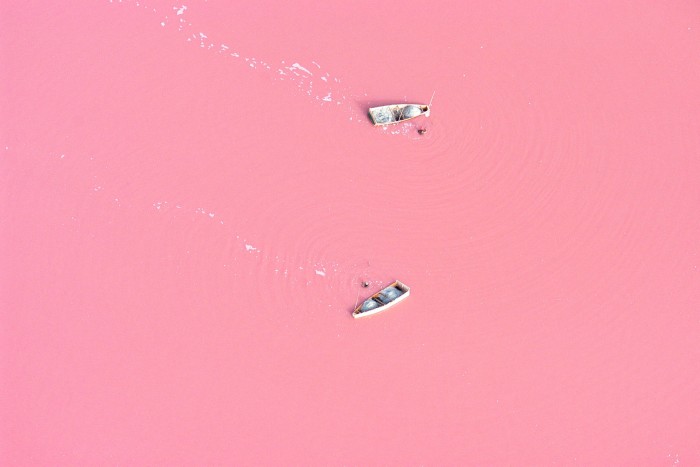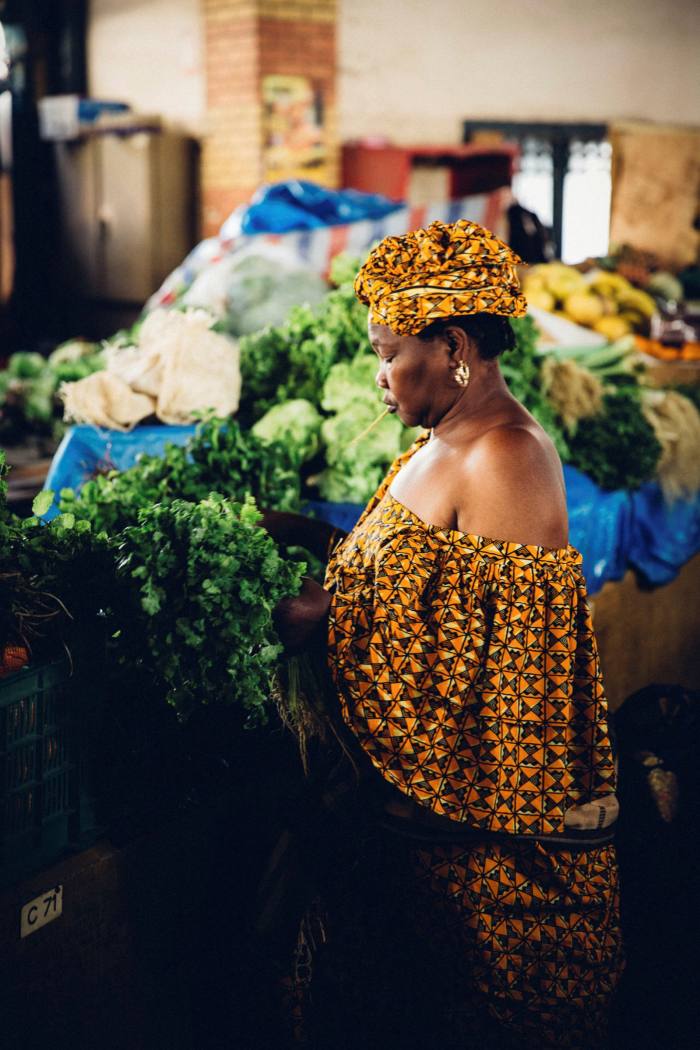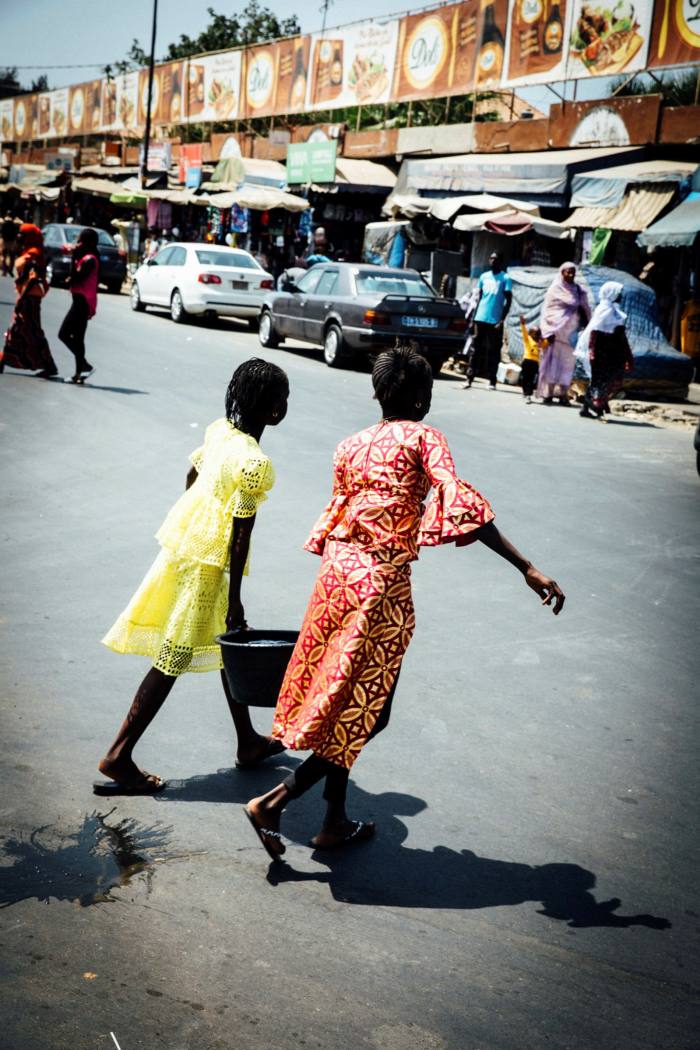We jump to the top of the podium, our arms aloft, imagining the cheers, trophies and champagne that greet the victors of a multi-day endurance rally. But other than a far-off crashing of waves, my husband, daughter and I are met only by silence. A dog sniffs at our feet while a local vendor sidles up to befriend us and try to sell us her beaded bracelets.
More than 15 years have passed since drivers in cars, bikes and quads traversed thousands of miles of desert and dune to complete the Paris-Dakar rally on the shores of Lac Rose in Senegal. The podium these days is difficult to discern among the crushed shells and mounds of salt.
But the lake, 15 miles north-east of the Senegalese capital, is still very much worth a visit. Lac Rose turns a deep pink in the dry season and can get saltier than the Dead Sea. Its salt harvest, one of the country’s exports and used in many a local dish, is gathered by thousands of men, while women called “gazelles” pack it. The lake, also known as Lake Retba, acquires its colour and salinity — in some places 10 times saltier than the sea — from a specific algae growth.
Our cheerful guide Samba steers his red wooden boat with a long pole, or rame, and takes us out towards the middle of the lake. We jump in for a dip and our feet swing straight to the surface. We can’t help but float. It is nigh- impossible to stretch our toes towards the lake bed barely three metres below.

Senegal’s capital fits into the scythe-shaped Cap Vert peninsula, the outer part of its hook reaching far enough into the Atlantic to lay claim to being the most western point of mainland Africa. A sandy beach in the neighbourhood of Les Almadies marks the tip of Africa, though sadly it is private, overlooked by a crumbling hotel that looks as if some time has passed since any visitor has stayed. A uniformed guard allows us to nip in for a photo but no more.
Instead we cool off in a natural pool in a neighbouring cove, protected from the open ocean by smooth jet-black rocks. Afterwards we dive into a restaurant to feast on clams, oysters, whelks and sea urchins, washed down with the local Gazelle beer and BaEauBab water. I buy a couple of bananas from a girl balancing a basket on her head.

To the south of Les Almadies, home to the imposing US embassy, the Corniche Ouest hugs the coastline and offers three tenets of Dakarois life in a few kilometres — fitness, fish and Islam. We become familiar with the route, navigating it either in one of the clapped-out black-and-yellow taxis or by strolling along one of Dakar’s few pavements. On one occasion, our cab is overtaken by a wheelchair-bound local hanging on to the back of a motorbike.
Fish markets, especially the Marché Soumbédioune at the southern end of the highway, come alive when the colourful painted boats haul in their daily catch. An outdoor gym squeezed between the road and the sea is at its most popular in the late afternoon as the sun goes down.

The highway brings us at eye level to the two 45-metre-high minarets of the spectacular white-and-red Mosquée de la Divinité, set below the Corniche in the ancient village of Ouakam. Cliffs surround us when we descend the steps to the beach in front of the mosque, where dozens of men and boys are being put through their paces in a rigorous fitness training programme.
I look straight up to the sky and squint at the 52-metre-high bronze statue that looms over the city. The Monument de la Renaissance, which is higher than the Statue of Liberty (not counting its pedestal), was built 12 years ago and has provoked controversy. Its $27mn cost was thought by many to be excessive, it was built by a North Korean construction company rather than Senegalese sculptors, and its figures’ clothing was deemed immodest by local imams. The statue, intended to celebrate Africa and its future, features a man who holds aloft a small child on his shoulder and grasps the hand of a young woman. I raise my eyebrows at their skimpy clothing, including the woman’s exposed breast, and wonder at the clash of culture.

The figures stand atop one of a pair of hills called Les Mamelles (from the French for “breasts” — though it is unclear if this was the sculptor’s inspiration or pure coincidence). On the neighbouring hill stands the brilliant white Phare des Mamelles, the lighthouse that has guided ships around Africa’s westernmost tip since 1864.
From the lighthouse, we admire the sweep of the coastline to the north. Right below lies the Plage des Mamelles, where we go for a mid-morning bissap, a local red-coloured drink not dissimilar to cranberry juice, and a buoye, a thick guava-like drink made from baobab sap. Both are cooling and delicious, and we sip them in a bar where recycled rubbish has been transformed into furniture and art. The chair, benches and tables have been crafted out of pallets and bits of driftwood and decorated with fishing nets. We sit below a painted black plastic bottle cut into the shape of a mermaid. The bar’s pet pelican keeps an eye on us.
Victor, the barman, displays plenty of Senegalese teranga, which roughly translates from Wolof as “welcome” or “hospitality”. He calls me “Mum” and accompanies my daughter Sophia and me back up the steep path, chatting all the way, to get a friend to break the 5,000 West African CFA franc note (less than $10) we have used to pay for our drinks.

It is one of those moments that encapsulate the joys of travel — and we enjoy many more over the days of our visit. We learn to chill in the Senegalese way, with a preference for the cool shade below a tree. For me, one of the great pleasures is whiling away the hours chatting with locals on a street corner drinking café au citron from a kiosk on wheels. The barista mixes Nescafé, sugar and water with a squeeze of lemon, whisking it all up for me to enjoy in one delicious gulp. Every day I expand my order — he also does a mean café au gingembre (ginger coffee), perfect for clearing the airways. We see very few older residents, a reminder that the median age of Senegal’s 17mn population is not quite 19 years old.


I gossip with my fellow coffee drinkers to the rhythmic sound of the young fellow nearby whose business is dicing onions for use in the local dish of yassa. Women, in bright dresses and matching head scarves, gather round on another corner and wash clothes in plastic tubs. A family stops on the pavement opposite to unwind a toddler, wearing nothing but a nappy and a smile, from the sling on his mother’s back. The local tailor saunters down the street, with his hand-crank Singer sewing machine on his shoulder, calling out with a clip of his scissors.
Just offshore lies the Ile de la Gorée, a vehicle-free island with a dreamy feel that has become an artists’ retreat. Its red-and-mustard-coloured houses are set among lush green vegetation; dozens of brightly painted fishing boats are pulled up on the beach. Baobabs, the symbol of Senegal, and palm and almond trees invite us to do like our Senegalese hosts and stretch out in their shade to chill. Soon a dog curls up next to us.


But beneath the pretty exterior lurks a grim history that has drawn presidents and a pope to feel the weight of history and pay their respects. From the 15th to 19th centuries, Gorée was a slave-trading port. We visit the House of Slaves, now a museum, and see the dungeons and cells where hundreds of shackled men, women and children were kept. From there, they were marched through the so-called “door of no return” and on to ships to the Americas. Some visitors who stay overnight report hearing cries and a feeling that the island is haunted.
President Barack Obama came to the island in 2013 with his family. Like us, he must have felt the magnitude and brutality of the slave trade hit him between the eyes. It was a visit he said he would “never forget”.
Sarah Provan is the FT’s deputy head of breaking news
Details
Sarah Provan visited Lac Rose with local travel agency Andaando (andaando.com), which also arranges trips throughout the country. Tour operators featuring Senegal include Intrepid (intrepidtravel.com)
Find out about our latest stories first — follow @ftweekend on Twitter

